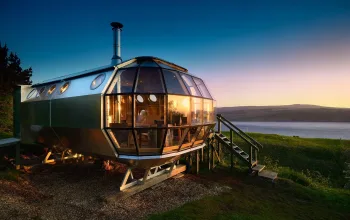SURFING
The next few months are the best time to be surfing in the UK as the weather and sea warm up, and most stretches of wave washed coastline will have a surf school or two to help get you up and riding. The warmest and most consistent surf is in SW England – Sennen is a good option with its huge white sand beach and regular swells (www.sennensurfschool.com) , or if you want plenty of après-surf action try Newquay (www.newquaysurfingschool.com).
For something off the beaten track try the wild coastline of the Outer Hebrides in NW Scotland (www.surflewis.co.uk).
COASTEERING
Coasteering was born in the 1980s on the St. David’s Peninsula in Pembrokeshire, and this still remains one of the best places to try this increasingly popular activity. The coastline here has everything from sheltered bays and low cliffs on which beginners can learn to exposed coastline and high sea cliffs where experienced coasteerers can enjoy the swells and big cliff jumps; award winning outdoor centre TyF Adventure (www.tyf.com) has routes to suit all levels of ability.
KITE SURFING
Considered by some to be the fastest growing watersport in the world, Britain’s wind- and wave-lashed coastline is ideal for kite surfing.
Wherever you are in the UK you’re never very from a good kite surfing venue; take Calshot Spit in Hampshire, for instance.
Easily accessed from most parts of SE England it offers a variety of sailing conditions from gently rolling high tide swells to flat waters at low tide. Check out www.kitesurfinguk.org.uk for more top venues around the UK.
STAND UP PADDLE BOARDING
This is the other contender for ‘fastest growing water sport’, and the ease with which you can pick up the basics and the variety of conditions you can practice it in make ‘SUP’ a great option if you’re looking for a new way of getting wet this summer.
You’ll learn on sheltered, flat waters from where you can progress to more lumpy seas and start to ride the waves; Bigbury-on-Sea in South Devon has conditions to suit all abilities and a good surf school, making it a top place to start SUPping www.discoverysurfschool.com
WAKE BOARDING
You need a lot of gear to get seriously into wakeboarding (not least of which is a boat!) so most people start off with a ‘wakeboard day’ at a centre such as Deeside Wakeboarding and Waterski Club (www.dwwc.org.uk) at Connah’s Quay in North Wales.
Wakeboard days will usually include land-based training before you hit the water for your first ride and maybe even an attempt to jump some wake.
The cost of a boat may be prohibitive but by joining a club you can overcome this.
WINDSURFING
This is another watersport in which Britain often has world class conditions, with the south coast of England being a hotbed of both recreational and competitive sailing.
Sites like Hayling Island offer great conditions to develop your skills; the smooth waters of Langstone Harbour and Chichester Harbour are good for beginners, whilst the regular sea breezes and surprisingly warm summer waters of West Beach provide more exciting conditions, and in winter can be seriously challenging. www.reach4thewind.co.uk
SEA KAYAKING
Back to Pembrokeshire again for this one, where top level sea kayak guide Nigel Robinson (www.seakayakguides.co.uk) can show you around the beautiful coastline of the Pembrokeshire Coast National Park or take you further afield for overnight expeditions to the area’s offshore islands.
As well as glorious scenery you can expect to see seals, porpoise, dolphins and maybe even whales as you paddle around the clear green, Gulf Stream-warmed waters.
COAST PATH WALKING
You don’t necessarily need to get wet to see the best of the British coastline. There are literally thousands of miles of coastal footpaths along which you can explore beaches, bays, coves and cliffs, discover birdlife from gannets and peregrines to puffins and shags and maybe see seals and dolphins playing in the swell.
Amongst the best are the 630-mile South West Coast Path (www.southwestcoastpath.com) which take you along the coastlines of Dorset, Devon, Cornwall and Somerset, the 870-mile Wales Coast Path (www.walescoastpath.gov.uk)and and the rugged and demanding Scottish Coastal Way (www.nationalcoastalpath.co.uk) which takes in various recognised long distance coastal trails along with paths that are not part of any official long distance trail.
SEA SWIMMING
Swimming in the sea is as far removed from swimming in a pool as you can get. No swimming lanes, no need to turn every 50-metres or so, and the pull and push of currents all make it a far more exciting and adventurous experience.
You’ll probably need a wet suit of some sort (although sunny coves and beaches in the south-west may be warm enough for swimming ‘sans-wettie’ in late summer) and you’ll need to be aware of tides and currents; and it goes without saying that the further out you swim the stronger a swimmer you need to be. www.wildswimming.co.uk
BELLYBOARDING
The cheap wooden bellyboards we all used as kids are back in fashion and provide the most basic, fun means of surfing there is.
Simply stand in the shallows, wait for a wave, leap aboard and bounce along in the foam to the shore.
It’s simple, anyone can do it and anyone can also enter the Bellyboard World Championships, which are held in Cornwall every September (www.bellyboarding.co.uk).
Bellyboarding is the most inclusive form of surfing there is, and is all about just one thing – having fun in the waves.





















